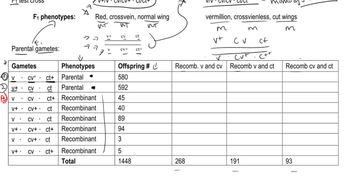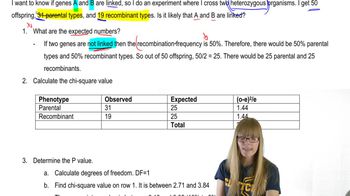Table of contents
- 1. Introduction to Genetics51m
- 2. Mendel's Laws of Inheritance3h 37m
- 3. Extensions to Mendelian Inheritance2h 41m
- 4. Genetic Mapping and Linkage2h 28m
- 5. Genetics of Bacteria and Viruses1h 21m
- 6. Chromosomal Variation1h 48m
- 7. DNA and Chromosome Structure56m
- 8. DNA Replication1h 10m
- 9. Mitosis and Meiosis1h 34m
- 10. Transcription1h 0m
- 11. Translation58m
- 12. Gene Regulation in Prokaryotes1h 19m
- 13. Gene Regulation in Eukaryotes44m
- 14. Genetic Control of Development44m
- 15. Genomes and Genomics1h 50m
- 16. Transposable Elements47m
- 17. Mutation, Repair, and Recombination1h 6m
- 18. Molecular Genetic Tools19m
- 19. Cancer Genetics29m
- 20. Quantitative Genetics1h 26m
- 21. Population Genetics50m
- 22. Evolutionary Genetics29m
4. Genetic Mapping and Linkage
Trihybrid Cross
Problem 26b
Textbook Question
The following progeny are obtained from a test cross of a trihybrid wild-type plant to a plant with the recessive phenotypes compound leaves (c), intercalary leaflets (i), and green fruits (g). (Traits not listed are wild type.) The test-cross progeny are as follows:
Phenotype Number
Compound leaves 324
Compound leaves, intercalary leaflets 32
Compound leaves, green fruits 5
Compound leaves, intercalary leaflets, green fruits 51
Intercalary leaflets 3
Intercalary leaflets, green fruits 309
Green fruits 42
Wild type 49
815
Calculate the frequencies of recombination between the adjacent genes in the map.
 Verified step by step guidance
Verified step by step guidance1
Identify the parental and recombinant phenotypes by looking at the numbers of progeny. The most frequent phenotypes are the parental types, while the least frequent are the double recombinants.
Determine the gene order by comparing the double recombinant phenotypes with the parental phenotypes. The gene that differs in the double recombinants is the middle gene.
Calculate the recombination frequency between the first and middle gene by adding the number of single recombinants for these genes and the double recombinants, then divide by the total number of progeny.
Calculate the recombination frequency between the middle and last gene by adding the number of single recombinants for these genes and the double recombinants, then divide by the total number of progeny.
Express the recombination frequencies as percentages to represent the genetic map distances between the genes.
Recommended similar problem, with video answer:
 Verified Solution
Verified SolutionThis video solution was recommended by our tutors as helpful for the problem above
Video duration:
3mPlay a video:
Was this helpful?
Key Concepts
Here are the essential concepts you must grasp in order to answer the question correctly.
Test Cross
A test cross is a genetic cross between an individual with an unknown genotype and a homozygous recessive individual. This method helps determine the genotype of the unknown parent by analyzing the phenotypes of the offspring. In this scenario, the wild-type plant is crossed with a plant exhibiting recessive traits, allowing for the observation of phenotypic ratios in the progeny to infer genetic linkage and recombination frequencies.
Recommended video:
Guided course

Trihybrid Cross
Recombination Frequency
Recombination frequency is a measure of the likelihood that two genes will be separated during meiosis due to crossing over. It is calculated by dividing the number of recombinant offspring by the total number of offspring, often expressed as a percentage. This frequency provides insight into the physical distance between genes on a chromosome, with higher frequencies indicating greater distances and lower frequencies suggesting closer proximity.
Recommended video:
Guided course

Recombination after Single Strand Breaks
Genetic Linkage
Genetic linkage refers to the tendency of genes located close to each other on a chromosome to be inherited together during meiosis. Linked genes do not assort independently, which can affect the expected ratios of phenotypes in offspring. Understanding genetic linkage is crucial for interpreting the results of a test cross, as it influences the recombination frequencies and the distribution of traits among progeny.
Recommended video:
Guided course

Chi Square and Linkage

 26:8m
26:8mWatch next
Master Trihybrid Cross with a bite sized video explanation from Kylia Goodner
Start learningRelated Videos
Related Practice

